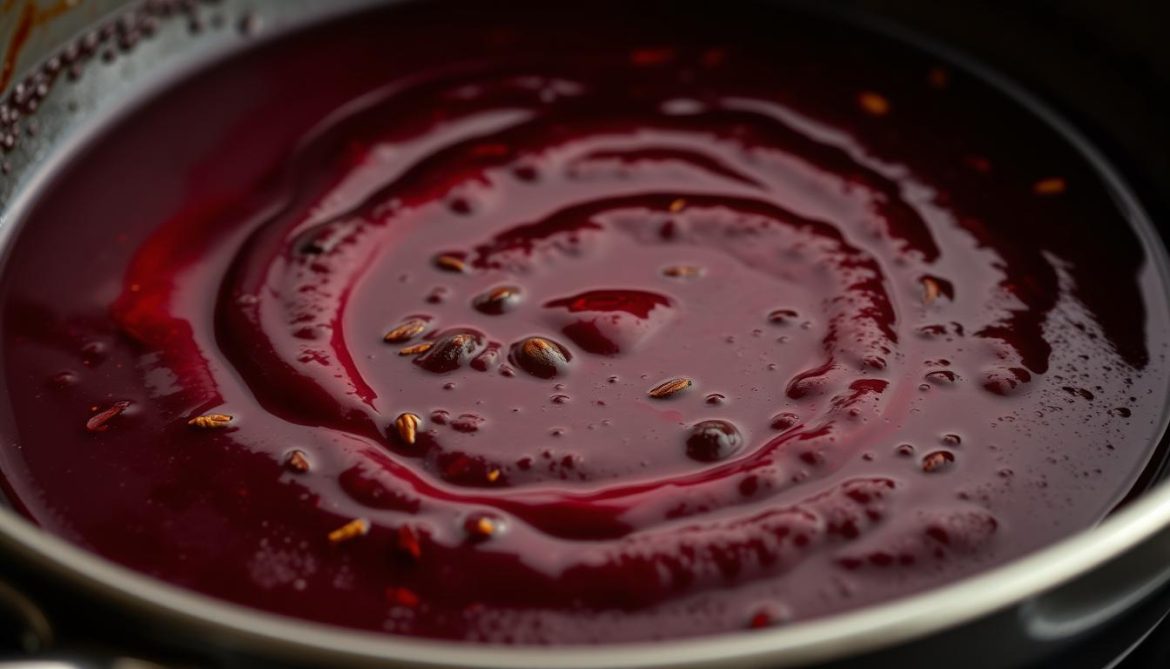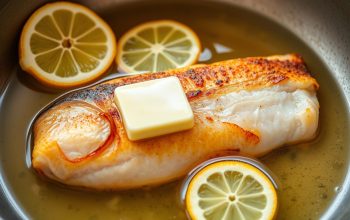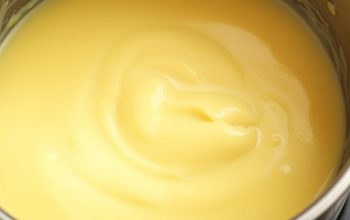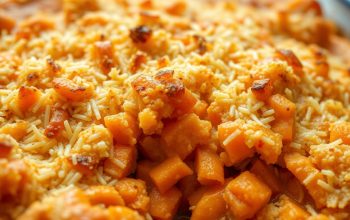Welcome, culinary adventurers! Making the perfect red wine sauce for meat dishes is more than cooking. It’s an art that turns simple meals into unforgettable experiences. Whether you’re cooking at home or dreaming of being a chef, mastering red wine sauce will make your meat dishes stand out!
Imagine making your kitchen taste like a fancy restaurant. A great red wine sauce can turn a basic steak, roast, or chicken into a gourmet delight. My love for cooking has shown me that the right sauce is about more than taste. It’s about creating moments that bring people together.
In this guide, I’ll share all you need to know about making amazing red wine sauce for meat dishes. You’ll learn about picking the best wine and mastering reduction techniques. You’ll get tips that will make your cooking impress everyone!
Your sauce-making journey begins here. Whether you’re new to cooking or have been doing it for years, these tips will change how you cook meat dishes. Let’s explore the world of red wine sauces and let your inner chef shine!
Understanding the Basics of Red Wine Sauce for Meat Dishes
Making a great red wine reduction is like an art. It turns simple meat dishes into amazing meals. Whether you want to make a classic beef bourguignon or just a simple steak, knowing how to make red wine sauce is key.
Now, let’s look at what makes a red wine sauce special. Making the perfect sauce needs skill and love.
Essential Ingredients for a Classic Red Wine Sauce
- High-quality red wine
- Shallots or onions
- Rich beef stock
- Fresh herbs (thyme, rosemary)
- Butter for finishing
The secret to a great red wine reduction is choosing the right ingredients. Your sauce should have depth, acidity, and rich flavors.
Wine Selection Tips for Cooking
When picking wine for your sauce, remember: you don’t need an expensive bottle. Choose dry red wines like Cabernet Sauvignon, Merlot, or Pinot Noir. Stay away from cooking wines, as they often have added salt and taste bad.
“The right wine can transform a good dish into an unforgettable meal.” – Culinary Wisdom
Basic Equipment Needed
- Heavy-bottomed saucepan
- Sharp chef’s knife
- Wooden spoon
- Fine mesh strainer
- Whisk
With these ingredients and tools, you’re set to start your red wine reduction journey. Whether it’s for a beef bourguignon or a simple sauce, these basics will help you make a perfect sauce!
The Science Behind Perfect Red Wine Reduction
Cooking is both art and science, and this is true for making the perfect red wine sauce for steak au poivre. Let’s explore the amazing chemical changes that turn simple ingredients into culinary wonders!
The Maillard reaction is key to those deep, rich flavors we all love. When heat meets proteins and sugars, something magical happens. This process creates those delicious brown notes that make sauces truly stand out.
- Proteins break down under heat
- Sugars caramelize and transform
- Flavor compounds develop intensely
Wine adds its own scientific magic to steak au poivre. Tannins and acids work with meat proteins, creating a taste symphony. Each molecule is crucial for complex flavors.
“Cooking is chemistry you can eat!” – Unknown Chef
For those who love steak au poivre, knowing these reactions means making sauces like a pro. The trick is to control temperature, manage reduction time, and pick the right wine.
Pro tip: Slow, gentle reduction focuses flavors and avoids bitter compounds. Your sauce will be grateful!
Classic French Techniques for Rich Wine-Based Sauces
French cuisine is known for its sophistication, and sauces are no exception. From Paris to kitchens worldwide, learning to make wine-based sauces can boost your cooking skills.
The Foundation of Mother Sauces
Knowing mother sauces is key for any chef. These basic sauces are the foundation for many dishes, like coq au vin. The main mother sauces are:
- Béchamel (white sauce)
- Velouté (light stock-based sauce)
- Espagnole (brown sauce)
- Hollandaise (emulsified egg sauce)
- Tomato sauce
Temperature Control Mastery
Controlling temperature is crucial for perfect wine-based sauces. For dishes like coq au vin, a gentle simmer is essential. It prevents burning and keeps the sauce smooth.
| Temperature Range | Sauce Technique | Outcome |
|---|---|---|
| 85-90°F | Low Simmer | Gentle Reduction |
| 90-95°F | Medium Heat | Consistent Flavor Development |
| 95-100°F | High Simmer | Rapid Reduction |
Reduction Techniques for Rich Flavor
Reduction is an art that turns simple liquids into rich sauces. For coq au vin, slow reduction enhances flavors and texture. Here’s how to do it:
- Select high-quality red wine
- Use a wide, shallow pan
- Stir occasionally
- Reduce by approximately 50%
- Strain for ultimate smoothness
“Cooking is like painting or writing a song. Just as a painter uses colors or a musician uses notes, a chef uses ingredients and techniques to create a masterpiece.” – Unknown Chef
By mastering these French techniques, your kitchen will become a gourmet haven. You’ll make sauces that wow even the pickiest eaters.
Best Wine Varieties for Different Meat Pairings
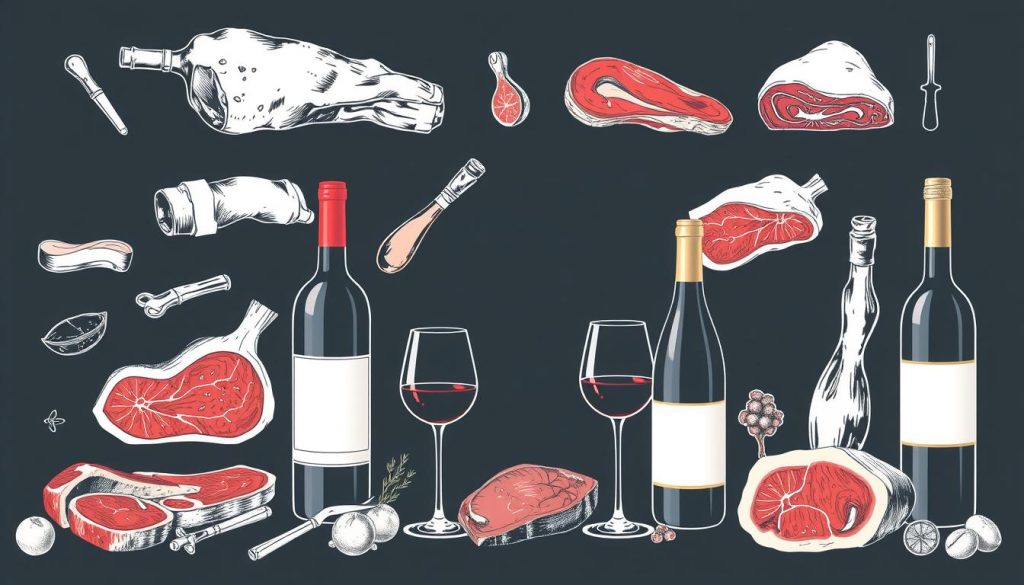
Finding the perfect wine for your meat dishes can make a meal special. For braised short ribs, the right wine can take the flavors to another level.
Let’s explore how to match wines with different meats:
- Beef Dishes: Full-bodied red wines like Cabernet Sauvignon and Syrah pair well with braised short ribs. They match the meat’s strong flavor and texture.
- Lamb Preparations: Choose Grenache or Zinfandel to go with lamb’s unique taste.
- Pork Selections: Lighter reds such as Pinot Noir are great with pork’s tender meat.
“Wine is the intellectual part of a meal, meats are merely the material.” – Alexandre Dumas
For braised short ribs, I suggest a bold Cabernet Sauvignon or a rich Malbec. These wines complement the meat’s deep flavors, making for a great meal.
Pro tip: Think about the sauce and cooking method when picking your wine. A dish with a red wine reduction will pair differently than a grilled one.
Step-by-Step Guide to Making Restaurant-Quality Demi-Glace
Making demi-glace might seem hard, but it’s doable with the right steps. This sauce can make your home cooking taste like a fancy restaurant. It’s perfect for dishes like lamb shanks.
Let’s explore the art of making demi-glace! It’s a concentrated sauce made from equal parts of espagnole sauce and brown stock. These are simmered slowly to create a rich, glossy sauce.
Traditional vs. Quick Methods
The traditional way needs patience and skill:
- Slowly roast beef or veal bones
- Create a rich brown stock
- Prepare espagnole sauce
- Reduce the mixture for hours
For those in a hurry, there’s a quicker method:
- Use pre-made stock
- Concentrate flavors with wine reduction
- Thicken with cornstarch or arrowroot
Storage and Preservation Tips
Keeping your demi-glace fresh is key. Here’s how to store it:
| Storage Method | Duration | Best Practices |
|---|---|---|
| Refrigeration | 5-7 days | Store in airtight container |
| Freezing | 3 months | Freeze in ice cube trays |
Common Troubleshooting Issues
Even pros face problems with demi-glace. Watch out for these issues:
- Burning the sauce during reduction
- Inconsistent thickness
- Lack of deep flavor
“The secret to a perfect demi-glace is patience and attention to detail.” – Professional Chef Recommendation
Mastering demi-glace will boost your cooking skills. It’s great for lamb shanks and other meats!
Signature Dishes Enhanced by Red Wine Sauce
Red wine sauce can turn simple dishes into amazing meals. Let’s explore some signature dishes that really come alive with this sauce!
Venison stew is a great example of how red wine sauce can elevate a dish. The game meat’s strong flavors match the rich taste of the wine sauce. This sauce brings out the meat’s subtle flavors.
- Classic Beef Bourguignon
- Braised Short Ribs
- Roasted Duck with Red Wine Glaze
- Venison Stew with Herb Reduction
These dishes are culinary wonders, with red wine sauce as the main attraction. The secret is finding the right balance between the sauce’s intensity and the meat’s natural taste.
“A great red wine sauce doesn’t overpower – it harmonizes.” – Chef’s Secret
| Dish | Wine Pairing | Sauce Intensity |
|---|---|---|
| Venison Stew | Cabernet Sauvignon | Medium-High |
| Beef Bourguignon | Pinot Noir | High |
| Braised Short Ribs | Merlot | Medium |
Pro tip: To make venison stew, slowly reduce the red wine sauce. This will concentrate the flavors. Your dish will taste like it’s from a top restaurant!
Adapting Wine Sauce for Different Cooking Methods
Learning to make red wine sauce is more than just a recipe. It’s about knowing how to adjust your cooking style. Whether you’re cooking a fancy beef tenderloin or a hearty weekend roast, the right sauce can make any meal special.
Braising: The Slow Magic of Flavor Development
Braising is a special way to make rich red wine sauces. It’s perfect for cooking tough meats slowly. This lets the wine and spices blend together beautifully.
- Select robust red wines that can withstand long cooking times
- Use beef tenderloin or other hearty meats that benefit from slow cooking
- Layer flavors by deglazing the pan with wine after initial searing
Pan Sauce Techniques for Quick Meals
Not every meal needs to take hours to cook. Pan sauces are a quick way to make beef tenderloin taste like it came from a restaurant. The trick is to reduce the sauce fast and add flavors carefully.
- Remove meat from pan and quickly deglaze with red wine
- Scrape up browned bits for maximum flavor intensity
- Reduce sauce until it reaches a glossy, slightly thickened consistency
Finishing Touches and Garnishes
The last touches can make your red wine sauce truly stand out. A bit of cold butter, fresh herbs, or a sprinkle of pepper can change how your sauce looks and tastes.
“Cooking is an art, and sauce is the paintbrush that brings your culinary canvas to life.” – Chef’s Wisdom
By mastering these techniques, you’ll be able to make red wine sauces that go well with any cooking method and meat. This will turn simple meals into unforgettable dining experiences.
Professional Tips for Sauce Consistency and Flavor Balance
Making the perfect red wine sauce for meat dishes is more than just mixing ingredients. It’s an art that needs precision, skill, and knowing how flavors work together.
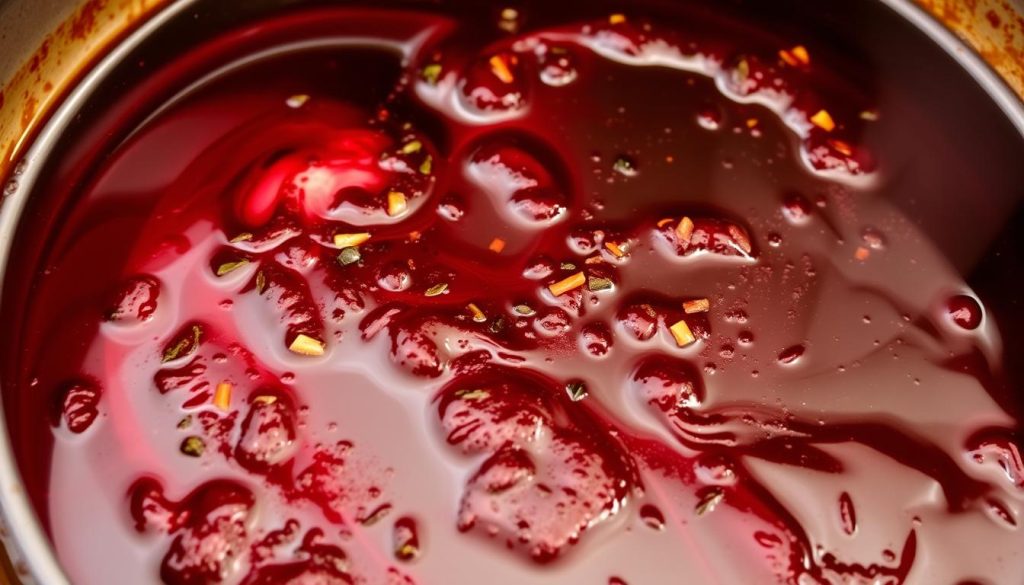
Here are the professional secrets to making a red wine sauce that will take your meat dishes to the next level:
- Reduction is Key: The secret to a deep red wine sauce is slow reduction. Let your sauce simmer slowly to concentrate the flavors and make them richer.
- Temperature Control: Keep the heat low to avoid separation and get a smooth, silky texture.
- Butter Finishing: Add cold butter off the heat to get a luxurious, glossy finish that makes your red wine sauce stand out.
“A great sauce is the difference between a good meal and an unforgettable dining experience.” – Professional Chef’s Wisdom
When making a red wine sauce, balancing flavors is key. Choose a wine that complements your meat. A strong red goes well with beef, while a lighter wine pairs better with chicken or pork.
Troubleshooting Common Sauce Challenges
- If your sauce is too thin, keep reducing it or use a cornstarch slurry
- For too acidic sauces, add a bit of sugar or butter
- Strain the sauce for a smooth texture
Professional chefs say a great red wine sauce is about balance, patience, and knowing how flavors mix. Try these techniques, and you’ll make sauces as good as those in fancy restaurants.
Make-Ahead Strategies and Storage Solutions
Let’s explore how to save time in the kitchen without losing flavor. Red wine reduction sauces are perfect for busy cooks. I’ll share my best tips for making these sauces ahead of time. This way, you can create gourmet meals even when you’re short on time.
Freezing is a great trick for red wine reduction. Pour your sauce into ice cube trays or small containers. These cubes can keep for up to 3 months, adding flavor to any dish instantly. Remember to label your containers so you know when they were made.
Storing sauces is an art. Use glass containers with tight lids for the fridge. Keep your sauce cold and use it within 4-5 days for the best taste. When reheating, stir gently to keep the sauce smooth and flavorful.
Preparation is key to easy cooking. Make big batches of red wine reduction on weekends. Then, portion and store them for quick meals during the week. This turns complex sauces into easy shortcuts that will wow your loved ones!
